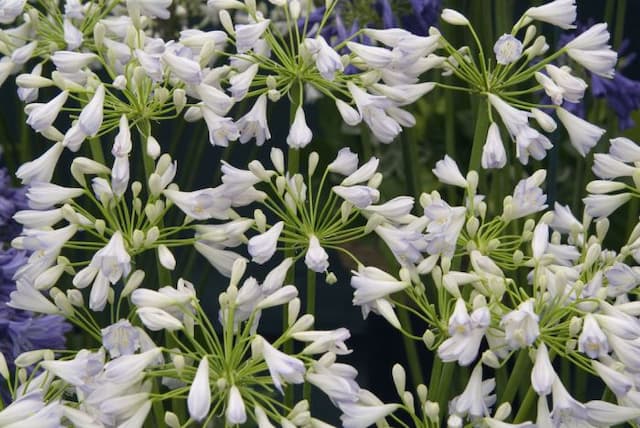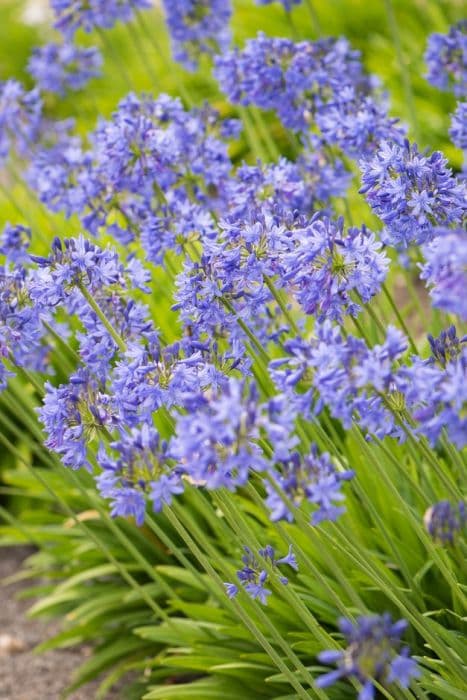Lily of the Nile Agapanthus 'Taw Valley'

ABOUT
Agapanthus 'Taw Valley' is a striking perennial commonly known as Lily of the Nile. It is characterized by its lush, strap-shaped, glossy green foliage that forms a dense clump, often arching gracefully. The leaves provide a verdant backdrop for the spectacular floral display that the plant is renowned for. The most eye-catching feature of Agapanthus 'Taw Valley' is its globular clusters of trumpet-shaped flowers, which are a bright, vivid blue with a hint of purple. These flowers are arranged in large, rounded umbels at the end of tall, sturdy stalks that rise elegantly above the foliage. The blooming period of this plant is usually in the summer, when it produces an abundance of these lush flower heads, creating a striking and colorful impact in any garden space. The combination of the bright, ornamental blooms and the lush green leaves make Agapanthus 'Taw Valley' a popular choice for borders, containers, and as an accent plant in landscaped areas.
About this plant
 Names
NamesSynonyms
Lily of the Nile, African Blue Lily, African Lily.
Common names
There are no synonyms for Agapanthus 'Taw Valley'; the basic scientific name is Agapanthus 'Taw Valley'.
 Toxicity
ToxicityTo humans
The Agapanthus, also known as African Lily or Lily of the Nile, contains compounds that can be toxic to humans if ingested. The plant, particularly the sap, has substances like saponins which can cause symptoms such as nausea, vomiting, abdominal pain, and diarrhea. In more severe cases, ingesting large amounts of the plant may lead to dehydration or electrolyte imbalances from vomiting and diarrhea. It is important for humans to avoid eating any part of the Agapanthus plant.
To pets
The African Lily is also toxic to pets, including dogs and cats. Ingesting parts of the plant can cause symptoms that are similar to those in humans, such as vomiting, diarrhea, nausea, and abdominal discomfort. In severe cases, ingestion could potentially lead to more serious health issues such as weakness or an irregular heartbeat due to the potential cardiotonic effects of certain compounds found within the plant. Therefore, it's crucial to prevent pets from chewing on or ingesting any part of the Agapanthus plant.
 Characteristics
CharacteristicsLife cycle
Perennials
Foliage type
Evergreen
Color of leaves
Green
Flower color
Blue
Height
2 feet (0.61 meters)
Spread
2 feet (0.61 meters)
Plant type
Bulb
Hardiness zones
8
Native area
South Africa
Benefits
 General Benefits
General Benefits- Ornamental Appeal: Agapanthus, commonly known as African Lily, offers striking blue or purple flowers that enhance the aesthetic of gardens and landscapes.
- Drought Tolerance: Once established, the African Lily is relatively drought-tolerant, requiring minimal watering and suitable for xeriscaping.
- Low Maintenance: It requires little care beyond the occasional feeding and watering, making it ideal for busy gardeners.
- Attracts Pollinators: The flowers attract bees, butterflies, and other pollinating insects, supporting biodiversity.
- Long Blooming Period: The African Lily has a lengthy bloom time, often from early summer until the first frost, providing long-lasting color.
- Container Gardening: It is well-suited for container planting, allowing those with limited space to enjoy its beauty on patios or balconies.
- Border Planting: African Lily is excellent for borders or as an accent plant due to its clumping habit and tall flower stalks.
- Cut Flowers: The blooms make for elegant cut flowers that can be used in floral arrangements.
- Deer Resistance: Agapanthus plants tend to be resistant to deer, making them suitable for gardens in areas with deer populations.
- Perennial Growth: As a perennial, it will return year after year, making it a sustainable addition to any garden.
 Medical Properties
Medical PropertiesThis plant is not used for medical purposes.
 Air-purifying Qualities
Air-purifying QualitiesThis plant is not specifically known for air purifying qualities.
 Other Uses
Other Uses- The sap of Agapanthus, also known as Lily of the Nile, can be used as a mild glue for small crafts due to its sticky nature.
- Agapanthus's sturdy, long stems may be utilized in creating natural supports for lightweight climbing plants or as part of floral arrangements.
- The seed pods of Lily of the Nile can be dried and used in decorative displays or as part of craft projects for their unique, textural appearance.
- Leaves of Agapanthus can be woven into small baskets or mats, taking advantage of their length and fibrous quality.
- When dried, the flowers of Lily of the Nile can be used as potpourri, filling a room with a subtle, sweet fragrance.
- The striking blue hue of Agapanthus blooms can be used as a natural dye for fabrics or paper, although it would be a pale, less vibrant color.
- During summer, the robust foliage of Lily of the Nile can provide a cool, shaded haven for small wildlife in the garden.
- Dried Agapanthus flowers can be incorporated into homemade candles for an aesthetically pleasing touch.
- Lily of the Nile can be used in educational settings to teach children about plant biology, especially the process of pollination and seed development.
- The abundant foliage of Agapanthus can be used as a natural privacy screen in gardens where small, less obstructive barriers are desired.
Interesting Facts
 Feng Shui
Feng ShuiThe African Lily is not used in Feng Shui practice.
 Zodiac Sign Compitability
Zodiac Sign CompitabilityThe African Lily is not used in astrology practice.
 Plant Symbolism
Plant Symbolism- Love Letters - The Agapanthus, often referred to as Lily of the Nile or African Lily, is derived from the Greek words 'agape' meaning love, and 'anthos' meaning flower. It symbolizes love and can be seen as a bearer of love letters or messages.
- Beauty - With its striking blue to purple flowers, the Agapanthus symbolizes beauty and a pleasing appearance, often associated with the beauty of nature.
- Endurance and Strength - Agapanthus plants are known for their longevity and ability to thrive with minimal care. They represent endurance, survival, and strength through difficulties.
- Fertility - In some cultures, the prolific blooming nature of the Agapanthus is associated with fertility and the creation of new life.
- Prosperity - The lush and bountiful appearance of the Lily of the Nile can also be seen as a symbol of abundance and prosperity.
- Freedom - The plant's growth habit of freely spreading may symbolize a sense of freedom and the idea of unrestricted life.
 Water
WaterAfrican Lilies should be watered regularly, especially during their growing season in spring and summer, to keep the soil consistently moist but not waterlogged. Typically, watering approximately once a week with around 1-1.5 gallons of water is sufficient, but this may vary depending on climate and weather conditions. During the winter months, watering can be reduced as the plants enter a dormant period. It is important to avoid overwatering as this can lead to root rot.
 Light
LightAfrican Lilies thrive best in full sunlight to partial shade. The ideal spot for these plants is one where they receive at least six hours of direct sunlight every day, which encourages robust growth and abundant flowering. However, they can also tolerate some light afternoon shade, especially in hotter climates.
 Temperature
TemperatureAfrican Lilies can survive in a range of temperatures, but they perform optimally when the temperature is between 50 and 80 degrees Fahrenheit. While they can tolerate temperatures down to about 20 degrees Fahrenheit for short periods, prolonged exposure to temperatures below freezing can be detrimental. For regions with cold winters, it's best to provide some protection or move the plants to a sheltered area.
 Pruning
PruningPruning African Lilies is primarily done to remove spent flower stalks and any dead or damaged foliage, which helps to encourage new growth and maintain a tidy appearance. The best time for pruning is in late fall or early winter, after flowering has ended. Pruning every year is usually sufficient for maintaining the health of the plants.
 Cleaning
CleaningAs needed
 Soil
SoilThe African Lily 'Taw Valley' thrives in a well-draining soil mix that consists of two parts loam, one part peat or compost, and one part sharp sand or perlite. This blend ensures proper aeration and moisture retention. The soil pH should ideally be in the range of 6.0 to 8.0, which is slightly acidic to slightly alkaline.
 Repotting
RepottingThe African Lily 'Taw Valley' should be repotted every two to three years or when it becomes root-bound. It's best done in the spring, just before the growing season begins, to give the plant time to establish in its new pot.
 Humidity & Misting
Humidity & MistingThe African Lily 'Taw Valley' prefers moderate humidity levels but is quite adaptable. It does not require any special humidity considerations, making it suitable for typical household environments.
 Suitable locations
Suitable locationsIndoor
Place in bright, indirect light and water sparingly.
Outdoor
Plant in full sun, protect from severe frosts.
Hardiness zone
8-11 USDA
 Life cycle
Life cycleAgapanthus 'Taw Valley', commonly known as Lily of the Nile, begins its life cycle as a seed which, when sown in fertile, well-drained soil and exposed to the right conditions, germinates to produce a seedling. The seedling grows into a vegetative, leafy stage, developing long, strap-like leaves and establishing a strong root system. Over time, this perennial establishes a clump-forming habit, from which flower stalks emerge during the summer months, typically in July or August. The flower stalks are topped with globular clusters of funnel-shaped flowers ranging in color from blue to violet. After flowering, the plant produces seed capsules, which upon ripening can be harvested for propagation or left to self-seed in the garden. In colder climates, the plant may die back in winter, but its rhizomatous roots remain dormant underground before resurging in the following spring.
 Propogation
PropogationPropogation time
Spring - Summer
Propogation: The most popular method of propagating the Agapanthus 'Taw Valley', commonly known as Lily of the Nile, is through division. This process is ideally done in the spring before the growing season starts or in the fall after the plant has finished blooming. To propagate by division, carefully lift the clump from the ground with a shovel, making sure to keep as many roots intact as possible. Then, using a sharp knife or spade, divide the clump into smaller sections, each with at least one or two healthy shoots. Replant the divisions immediately at the same depth they were originally growing, spacing them about 18 inches (approximately 45.72 centimeters) apart to allow for ample growing space. Water the newly planted divisions thoroughly to help establish them. Over time, these new plants will grow and mature into flowering specimens.









